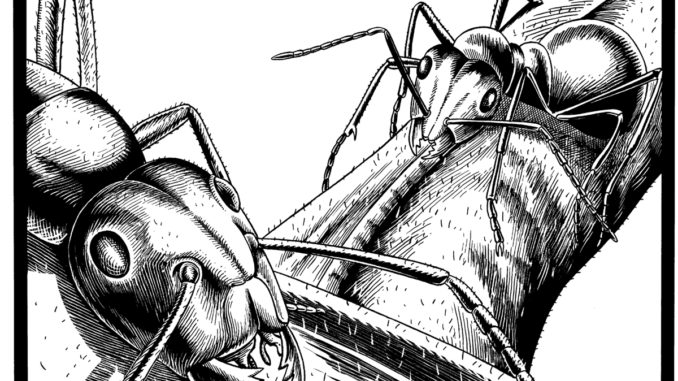
The total global biomass of all species of ants equals ours
By R. Gary Raham
Humans can (and do) take great pride in their ability to raise and nurture plants. We pamper orchids and roses. Like Johnny Appleseed, we leave a trail of trees wherever we go. We’ve vastly improved the native ranges of corn, wheat, and rice, our favorite food grains. Nevertheless, we shouldn’t overlook our formidable competition in the field of plant management: the ants. According to entomologists Bert Holldobler and Edward O. Wilson, the total global biomass of all species of ants equals ours and they’ve been practicing their skills far longer. “Ants have lived on Earth for more than ten million of their generations; we have existed for no more than a hundred thousand generations.” Like us, ants use plants, but plants get perks out of the interactions, too.
Ants go about their business without notice unless we happen to see a trail of them hauling off donut crumbs from the kitchen or we watch with mild alarm as a swarm of winged ants boil out of a crack in the front sidewalk and fly around in a literal orgy of excitement. We may also pause to watch their comings and goings when we notice their nest mound along a trail or in a field. Our arid, prairie habitat supports some of the most avid ant horticulturists: the harvester ants, members of the genus Pogonomyrmex.
Harvester ants have long served as role models because of their industry in collecting and storing plant seeds. Solomon wrote: “Go to the ant, thou sluggard; consider her ways, and be wise: Which having no guide, overseer, or ruler, Provideth her meat in the summer, and gathereth her food in the harvest.” David F. Costello in The Prairie World estimates that grasslands support about 500,000 ants per acre. A large colony can collect a pint of seeds per day from plants such as pigweed, goosefoot, squirrel tail, prickly poppy, needle & thread grass, hairy goldaster, and rubber rabbitbrush.
All this harvesting produces extensive effects. Holldobler and Wilson contend “Ants are keystone species, deciding by their presence alone which of the plants flourish and which fail.” They cite an Arizona study where researchers removed ants from certain desert plots. Within two seasons, annual plants grew back at twice their normal density. Ants also provide a service to these plants: As the insects are jogging their 528 minute miles, a few seeds fall by the wayside and germinate in pristine territory.
Normally, harvesters insure that the seeds they collect don’t germinate in their nest by nipping off the radicle of each seed—the primary root that first emerges from the plant embryo. Like good farmers, they store each seed type in separate bins or chambers within the nest granary area. A harvester’s nest is a comfortable domicile that can be anywhere from a few feet to ten yards across and serve a colony for at least twenty years. The ants excavate galleries that may extend 9-12 feet below ground. They regulate humidity by carrying in droplets of moisture as necessary. The queen, eggs, larvae, pupae, immature workers, and adults live in the upper galleries during summer. The queen and adult workers head for the basement in winter and hibernate. Ants share space with various guests and intruders, including smaller ant species, beetles, parasites, crickets, termites, and worms.
Fortunately, harvester ants don’t unduly pester their human neighbors. Now and then they may decide to perform their mating swarm orgy over a chimney and fall inside or may accidentally swarm near a house foundation and find their way inside through cracks, but they don’t take up permanent residence. In rare cases, some species of carpenter ants and pharaoh ants may establish permanent nests within a home that will require some kind of treatment.
Holldobler and Wilson say, “At the present time we know hundreds of plant species in more than 40 families that possess special structures to house ants.” Many also produce nectaries and food bodies. These plants include legumes (the pea family of which the acacias are members), euphorbs, madders, melastomes, and orchids. Hundreds of species of ants participate in these associations.
So, when your green thumb throbs with accomplishment, reflect on those thumbless red harvesters in the mound near the sidewalk that have been engineering plant growth and placement since the days of the dinosaurs.
Support Northern Colorado Journalism
Show your support for North Forty News by helping us produce more content. It's a kind and simple gesture that will help us continue to bring more content to you.
BONUS - Donors get a link in their receipt to sign up for our once-per-week instant text messaging alert. Get your e-copy of North Forty News the moment it is released!
Click to Donate



1 Trackback / Pingback
Comments are closed.